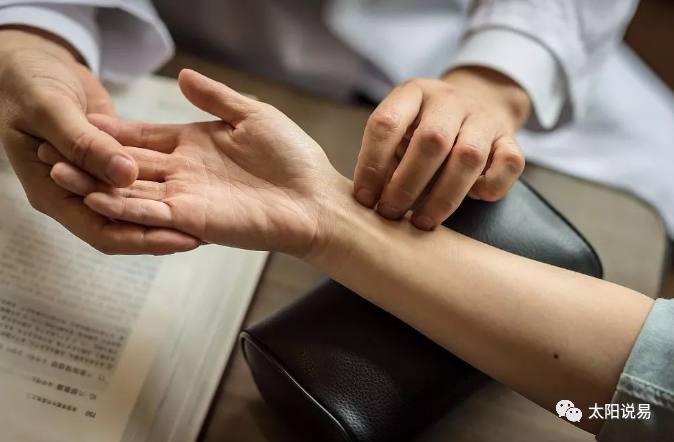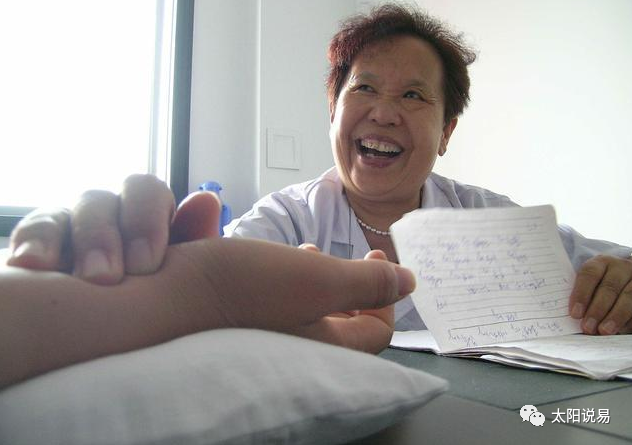
In Traditional Chinese Medicine (TCM), the pulse is considered the vessel of blood, circulating throughout the body. The qi and blood of the five zang (organs) and six fu (hollow organs) must flow through the blood vessels. When the body is stimulated by internal or external factors, it inevitably affects the circulation of qi and blood, leading to changes in the pulse. Practitioners can assess the condition of the zang-fu organs, the abundance or deficiency of qi and blood, and the presence of pathogenic factors by understanding the depth, speed, strength, rhythm, size, and smoothness of the pulse. As mentioned earlier, the floating pulse (fu mai) is easily felt with light pressure and diminishes with heavier pressure; it is a yang pulse, indicating exterior conditions, heat syndromes, and also deficiency syndromes.

Today, we will focus on the **沉脉 (chen mai)**, or the sinking pulse. The sinking pulse is characterized by a deeper location where it cannot be felt with light pressure; in moderate pressure, it is extremely weak, almost imperceptible, and requires heavy pressure to be felt distinctly beneath the muscles. Thus, the text Mai Yu states: “The sinking pulse is obtained beneath the muscles.” The sinking pulse primarily indicates a deeper pulse position, contrasting with the floating pulse. Ancients compared the sinking pulse to “sand wrapped in cotton” or “a stone thrown into water.” In texts like the Nei Jing and Nan Jing, the terms ‘sinking’ and ‘stone’ are often used interchangeably to describe pulse characteristics. The sinking pulse is characterized by being unresponsive to light pressure and only discernible with heavy pressure, indicating a softness on the outside but hardness on the inside. Therefore, Zhen Zong San Mei also states: “The sinking pulse is unresponsive to light pressure and only discernible with heavy pressure; lifting the finger reduces the response, while pressing harder increases the strength, yet it does not respond immediately to the finger.”

The mechanism of the sinking pulse can be attributed to two main factors: one is the internal stagnation of pathogenic factors, leading to qi and blood being trapped internally; the other is the deficiency of qi and blood in the zang-fu organs, resulting in weak pulsation. If the pulse is sinking and strong, it indicates an internal excess condition due to pathogenic factors; if the pulse is sinking and weak, it indicates an internal deficiency condition. Modern medicine suggests that the formation of the sinking pulse is related to the volume of blood ejected by the heart, peripheral vascular resistance, and its state. A decrease in the volume of blood output from the heart, lower blood pressure, reduced vascular pressure, and insufficient blood volume are the primary causes of the sinking pulse. The sinking pulse can also be classified into pathological and normal pulses. For instance, the Nei Jing describes the normal seasonal pulses: “Spring is Xian, Summer is Hong, Autumn is Mao, and Winter is Shi.” The Zhen Jiu Jia Yi Jing states: “Winter pulse is related to the kidney, associated with the northern water element, where all things converge and are stored, hence its qi is sinking and moistening.” This means that a sinking pulse observed in winter, with a normal count, and a calm and gentle pulse is considered a normal pulse. Additionally, in women, the cun pulse (寸脉) and in men, the chi pulse (尺脉) can also be normal if they are sinking without other symptoms and with a normal count, as this is their physiological norm.

The sinking pulse is hidden deep, indicating insufficient yang qi and an excess of yin qi. Generally, it indicates internal conditions, belongs to yin, signifies diseases located below, indicates cold, phlegm, dampness, food stagnation, qi disorders, and pain. According to the principle of correspondence between heaven and man, the sinking pulse reflects the sedimentation of the earth in nature, similar to the changes in the pulse in the human body, thus the sinking pulse symbolizes the descent of the earth, akin to a deep spring underground. In the Eight Trigrams, Kan represents the northern water trigram, which is associated with yin and corresponds to the cold water of the north, where it condenses and stores. In winter, all things are collected and return to their roots. Therefore, the sinking pulse corresponds to the Kan trigram and the winter season of storage. In the human body, the kidney governs the interior, located in the lower jiao, and is responsible for storage, hence the kidney pulse is also referred to as the stone pulse. Due to its deep location and its pulsation being close to the bones, it is also referred to as the营 (ying) pulse. The sinking pulse can be observed in the cun, guan, and chi positions, and can also be seen in conjunction with other pulses.

The sinking pulse primarily indicates internal conditions, but it can also be differentiated into yin, yang, deficiency, and excess. A sinking pulse that is strong indicates an internal excess, while a sinking pulse that is weak indicates an internal deficiency. For instance, if yang deficiency leads to cold, the pulse will be weak and sinking, indicating internal deficiency, with a sinking, slow, and weak pulse. If the condition is due to excess yin causing internal stagnation, qi stagnation, blood stasis, or food accumulation, the pulse will be sinking and strong, indicating internal excess. In the three pulse positions, the left cun reflects the heart, and the right cun reflects the lung. If the yang of the heart and lung is insufficient, the pulse will be weak due to insufficient heart yang and lung qi, leading to fluid retention and phlegm accumulation, thus the cun pulse is often sinking due to phlegm stagnation or water retention in the chest. The left guan reflects the liver and gallbladder, and the right guan reflects the spleen and stomach. If there is liver and gallbladder stagnation or cold congealing in the spleen and stomach, it can lead to dysfunction in the middle jiao qi mechanism, resulting in pain. Therefore, a sinking guan pulse often indicates cold congealing in the middle jiao, qi stagnation, and pain. If the pain is due to cold, the guan pulse will be sinking and slow; if due to liver and gallbladder stagnation, the pulse will be sinking and wiry. The chi position reflects the kidney and governs the lower jiao. Thus, a sinking chi pulse is often seen in conditions like damp-heat, urinary incontinence, seminal emission, diarrhea, and lower back pain due to kidney deficiency. However, conditions like seminal emission due to kidney deficiency, urinary incontinence due to bladder dysfunction, and diarrhea due to insufficient warming from the kidney fire, all belong to deficiency syndromes, and the pulse should be sinking and weak.

The sinking pulse is a significant independent pulse pattern, characterized solely by its location without other influencing factors. Its strength can vary, its speed can be rapid or slow, and its rhythm is not dictated by form. Therefore, the sinking pulse can present with various accompanying pulses, indicating a wide range of diseases and complexities. For example, there can be sinking and rapid, sinking and slippery, sinking and slow, sinking and knotty, sinking and relaxed, sinking and thin, sinking and rough, sinking and weak, sinking and wiry, sinking and tight, sinking and firm, sinking and scattered pulses, etc. Conditions like internal water retention or deficiency-cold in the yin channels can also present with a sinking pulse, often appearing as sinking and wiry or sinking and slow. The sinking pulse primarily indicates qi disorders and water retention; when seen with other pulses, it can manifest different symptoms such as cold, heat, deficiency, excess, phlegm, water, food stagnation, pain, accumulation, and stagnation. Clinically, a sinking pulse combined with a rapid pulse indicates internal heat; a sinking pulse combined with a slippery pulse indicates phlegm food accumulation; a sinking pulse combined with a rough pulse indicates qi stagnation; a sinking pulse combined with a weak pulse indicates cold-heat; a sinking pulse combined with a relaxed pulse (or soft pulse) indicates dampness; a sinking pulse combined with a wiry pulse indicates phlegm retention or various pains; a sinking pulse combined with a tight pulse indicates cold accumulation pain; and a sinking pulse combined with a firm pulse indicates cold accumulation, among many others. This requires us to continuously summarize experiences in specific clinical practices, observe pulse patterns, and accurately determine conditions through the four examinations.

Here, we must also note an important distinction: the sinking pulse must be differentiated from the **伏脉 (fu mai)**, or the hidden pulse. Both the sinking and hidden pulses are located deep beneath the skin and require heavy pressure to be felt, but the sinking pulse is closer to the muscles and bones, while the hidden pulse must be pressed against the bones to feel the pulsation. This distinction should not be difficult to make.

Unveiling the ‘Floating Pulse’ in TCM
A formula from Fu Qing Zhu Nu Ke uses harmonizing herbs, yet has remarkable effects.
There is a type of headache known as ‘heat syncope headache’; how much do you know about it?
There is a type of headache known as ‘heat syncope headache’; how much do you know about it?
A formula from Li Dongyuan, although related to the nine orifices, is connected to the zang-fu organs.
A formula from Li Dongyuan does not contain qi-regulating herbs; why is it named ‘guiding qi’?

